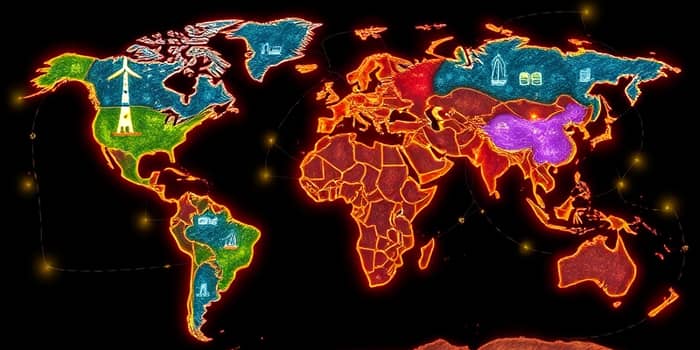
In 2025, the intersection of geopolitics, markets, and technology is reshaping how nations produce, trade, and secure energy. From renewables surging ahead to coal’s lingering presence, this global outlook examines the forces driving our shared energy future.
Energy remains a powerful tool in international relations. As major powers pivot, traditional supply routes are being redrawn, alliances recalibrated, and dependencies challenged. Russia’s strategic shift eastward after losing key European markets has created new corridors, while China’s role as a swing consumer places it at the heart of global demand.
Western nations, particularly in Europe, are accelerating efforts to wean themselves off Russian oil and gas. Massive investments in offshore wind, hydrogen infrastructure, and cross-border interconnectors highlight a collective push toward renewable energy independence. In the United States, policy changes under the Inflation Reduction Act and reshoring incentives are fostering a domestic manufacturing renaissance for batteries and solar modules.
Producers such as Iran and Gulf States face volatile revenues amid sanctions, emerging alliances, and accelerating competition in clean technologies. Saudi Arabia and the UAE are diversifying into green hydrogen, while Russia and Qatar vie for market share in the global LNG trade.
Investors poured a record $2.2 trillion into energy in 2025, with the lion’s share directed toward renewables, grids, storage systems, and low-emissions fuels. Even as some policies waver, capital continues to flow into clean power, marking a profound shift in where growth opportunities lie.
Renewables accounted for a staggering 92.5% of new power capacity in 2024, dwarfing additions from coal and gas. China has emerged as the undisputed leader, with clean energy now representing about 10% of its GDP. Meanwhile, Europe’s Green Deal and the U.S. Inflation Reduction Act are fueling unprecedented deployment, even as debates over permitting and subsidies persist.
Rapid cost declines in solar and wind have upended traditional cost curves. Utility-scale solar is now 41% cheaper than fossil fuel–based generation, while onshore wind enjoys a 53% price advantage. Such economics have driven record installations worldwide, with projections suggesting renewables could supply up to 74% of power by 2050 under ambitious scenarios.
Investment in grid modernization and battery storage is crucial to managing intermittency. Smart inverters, AI-driven demand response, and long-duration storage trials are proliferating. Meanwhile, advanced nuclear technologies—small modular reactors—and geothermal projects are gaining traction as baseload complements in select regions.
Despite global calls for a coal phaseout, consumption is dropping unevenly. Non-OECD countries, particularly in Asia-Pacific, still rely on coal for up to 60% of their electricity, though overall burn is set to decline by as much as 93% in the most aggressive decarbonization pathways.
Electrification drives the next wave of energy demand. Transport, industry, and buildings are increasingly powered by electrons rather than hydrocarbons. AI and data centers add new base loads. By 2050, global primary energy demand may plateau around 600–750 QBtu, depending on the speed of renewables uptake and efficiency improvements.
Regional trajectories vary dramatically. China dominates in capacity growth, with solar installations expected to quintuple between 2023 and 2030. India and ASEAN nations are ramping up renewables and grid upgrades, while Africa and Latin America grapple with electrification challenges and funding gaps.
As renewable deployment accelerates, stress on existing infrastructure intensifies. Grids must adapt to higher peaks and more volatile flows, all while fending off cyber threats and extreme weather events. Investments in resilience and redundancy are no longer optional.
Supply chains for critical minerals—copper, lithium, cobalt, and rare earths—face bottlenecks amplified by geopolitical frictions. Trade disputes, export restrictions, and transportation delays threaten project timelines worldwide. Simultaneously, manufacturing capacity constraints for key components, like wind turbines and electrolyzers, pose additional hurdles.
Financing remains a formidable barrier, especially in developing regions. Despite declining levelized costs of renewables, up-front capital requirements and perceived risks limit project bankability. Multilateral development banks and green bonds are filling some gaps, but they cannot replace private sector scale.
2025 is a pivotal year. The global energy transition index rose 1.1%, more than doubling previous annual improvements. Yet readiness for future shocks—economic, climatic, or geopolitical—lags behind deployment momentum.
Renewables now drive about three-quarters of electricity growth, but 770 million people still lack access to reliable power, mostly in sub-Saharan Africa and parts of South Asia. Bridging this divide requires both decentralized solutions, such as mini-grids and solar home systems, and large-scale grid extensions.
Projections vary widely based on policy ambition and market forces. In the Reference scenario, fossil fuels maintain a significant share through 2050, with renewables steadily gaining ground. Under Evolving Policies, coal declines faster, and electric mobility surges. The most aggressive Ambitious Climate pathway sees oil demand drop to 25 million barrels per day by 2050 and coal use fall by up to 93%.
However, achieving such outcomes requires unprecedented global coordination and investment. Macroeconomic headwinds—global GDP growth slowing from 3.3% in 2024 to around 3.1% by 2026—could dampen demand elasticity and slow transition financing.
Key uncertainties abound: Will trade and technology conflicts fragment supply chains? Can capital flow to emerging markets at scale? Will grids evolve rapidly enough to handle surging renewables? How will persistent gas use align with net-zero ambitions? And how will geopolitical and climate shocks reshape the energy equation?
As the world navigates this complex geoeconomic terrain, the stakes could not be higher. Energy security, climate goals, and economic development are intertwined more tightly than ever. The choices made today will resonate through decades, shaping the prosperity and resilience of nations and communities alike.
By understanding these dynamics, stakeholders—from policymakers and investors to communities and consumers—can make informed decisions that accelerate a just and secure energy transition. In the coming years, collaboration, innovation, and strategic foresight will define winners and losers in the global energy arena.
References





